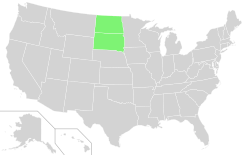The Dakotas
The Dakotas is a collective term for the U.S. states of North Dakota and South Dakota. It has been used historically to describe the Dakota Territory, and is still used for the collective heritage,[2] culture, geography,[3] fauna,[4] sociology,[5] the economy,[6][7] and cuisine[8] among the two states.
The Dakotas | |
|---|---|
Region | |
 North and South Dakota in light green | |
| Country | |
| States | |
| Admission to Union | November 2, 1889 (both North and South Dakota) |
| Area | |
| • Total | 147,816 sq mi (382,840 km2) |
| Area rank | 4th |
| Population (2019)[1] | |
| • Total | 1,646,721 |
| • Density | 11/sq mi (4.3/km2) |
| Demonym(s) | Dakotan |
Overview
The two states combined have a population of 1,592,657, slightly less than Idaho, ranking at 40th place. The Dakotas have a total area of 147,878 square miles (383,177 square kilometres), which would rank 4th among U.S. states, right before Montana. The two states also have a population density of 9.8 per sq. mi (3.8 per km2).
The Dakotas are within the Midwestern United States, with the western portion in the High Plains. The PBS miniseries New Perspectives on the West noted historically important areas within the Dakotas, including the Black Hills, the town of Deadwood, Fort Buford, Standing Rock Reservation and Wounded Knee.[9] The Upper Missouri River and the Upper Missouri River Valley are important geological features in the area, as well.
The area is mostly inhabited by people of Northern European origin. 44.9% of the population are of German ancestry, 21.8% of Norwegian, and 9.6% are of Irish heritage.
Both of the Dakotas have humid continental climate, with warm to hot summers and cold to even subarctic temperatures in winter. Due to the difference in circle of latitude, temperatures differ by degrees between the southern and northern areas, even inside the respective states.
Main cities
The following are the top ten most populous cities (not in order) in The Dakotas. Pierre, South Dakota, and Bismarck, North Dakota, are the respective state capitals.
Bibliography
- McMacken, R. (2006) Off the Beaten Path: The Dakotas. Globe Pequot.
See also
- The Californias
- The Canadas
- The Carolinas
- The Floridas
- The Virginias
References
- "Population, Population Change, and Estimated Components of Population Change: April 1, 2010 to July 1, 2019 (NST-EST2019-alldata)". Census.gov. United States Census Bureau. Archived from the original on January 26, 2020. Retrieved February 8, 2020.
- "Serengeti in the Dakotas", Scientific American. May 2007. Retrieved 4/20/08.
- "Prairie Basin Wetlands of the Dakotas: A Community Profile. USGS Northern Prairie Wildlife Research Center. Retrieved 4/20/08.
- "Wild Horses in Montana and the Dakotas", Retrieved 4/20/08.
- "Time Passages, Genealogy of the Dakotas". Retrieved 4/20/08.
- "Dakotas rank high on congressional pork list", ArgusLeader.com. April 2, 2008. Retrieved 4/20/08.
- "Black Gold in the Dakotas", Dakota Voice. April 6, 2008. Retrieved 4/20/08.
- Wieland, K. (2007) The Dakota Diet: Health Secrets from the Great Plains. Basic Health Publications.
- "New perspectives on the West: The Dakotas", PBS. Retrieved 4/20/08.
External links
- Historic map of the Dakotas